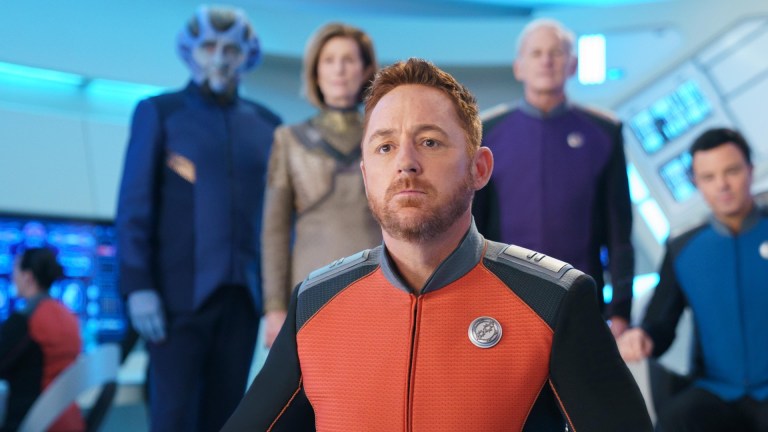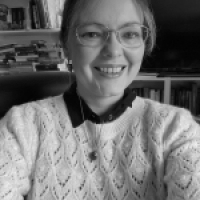The Orville Is Actually Much Darker Than You Think
The Orville was never the light-hearted Star Trek spoof it was pitched to be.

This article contains spoilers for The Orville, Star Trek: The Original Series, and Star Trek: Strange New Worlds.
Featuring broad comedy and characters who don’t seem to be taking their jobs very seriously, the first trailer for The Orville suggested that the Fox series would be a spoof of Star Trek.
In said trailer, Captain Mercer (Seth MacFarlane) tries to eat a marble and asks an alien to move over so he is framed better in the viewscreen. Lt. Gordon Malloy (Scott Grimes) drinks beer while on duty, flying a shuttle, at 9:15 a.m. Commander Kelly Grayson’s (Adrianne Palicki) former marriage to Mercer is treated to rather stale “comic” arguments about going to therapy. Mercer’s reaction to Lt. Commander Bortus’s (Peter Macon) species being entirely male is to observe, with truly cutting and original wit, that they probably don’t have many arguments about leaving the toilet seat up. (The response, that they only urinate once a year, is much more original and funny).
But most of that broad comedy turned out to be restricted to the pilot. Over the course of its first two seasons, The Orville became less a spoof of Star Trek shows, and more like a Star Trek series itself, one modelled after the late 1990s and early aughts branches of Star Trek (The Next Generation, Deep Space Nine, Voyager, and Enterprise). It was also always much darker than you think.
The Orville Had Deep Star Trek Connections
The Star Trek similarities aren’t very surprising when you look at some of the people involved in making the show. The Orville features Deep Space Nine’s Penny Johnson Jerald (who played Captain Sisko’s girlfriend Kassidy Yates) in a regular role as the ship’s doctor Claire Finn. It guest-stars The Next Generation’s Marina Sirtis, Voyager’s Robert Picardo and Tim Russ, and Enterprise’s John Billingsley. The show’s directors include Star Trek’s Brannon Braga, Robert Duncan McNeill, and Jonathan Frakes. Most importantly, Braga and his current writing partner Andre Bormanis have written seven episodes. Other episodes have been written by Joe Menosky (who has written for The Next Generation, Deep Space Nine, Voyager, and Discovery) and David A. Goodman (who has written for Enterprise).
Anyone watching The Orville from the beginning will have noticed it making a slow move towards being less comedic and more dramatic over its three seasons. The first season featured episodes that twisted Star Trek tropes, like “Cupid’s Dagger,” which gender-flips the storylines about an alien guest exuding a sex pheromone that affects the crew’s behavior that were often given to Majel Barrett’s Lwaxana Troi in ’90s Trek.
Other episodes in that first season played out almost exactly like ’90s Trek episodes – “Mad Idolatry” combines The Next Generation’s “Who Watches the Watchers” with Voyager’s “Blink of an Eye.” Meanwhile, “Into the Fold,” co-written and directed by Braga, is almost a rerun of Voyager’s “Innocence.” This trend towards less comedy and more drama continued with increasingly dramatic storylines throughout season 2, culminating in a war with Isaac’s (Mark Jackson) species of artificial lifeforms, the Kaylon.
New Horizons Was a New Beginning
Eventually, season 3 moved from Fox to streamer Hulu and was slightly rebranded as The Orville: New Horizons. MacFarlane told Collider that the new subtitle was an idea pitched to him by Dana Walden at Disney, and that “I thought it was kind of cool because it’s not a reboot, it’s a continuation, but it was just enough to tell the audience that we’re expanding a little bit. That the scope is bigger. The show is more ambitious.”
The trailers for The Orville: New Horizons dropped the feeling of a “spoof” all together, presenting the show as a more straightforward, if sometimes light-hearted, sci-fi drama. This trailer opens with Mercer quoting Percy Bysshe Shelley’s famous poem “Ozymandias” (which had been name-checked in the final season of Breaking Bad in 2013) and features diplomats sitting around a table, explosions, and dialogue emphasizing dramatic themes like risks, danger, peace, and heart. There’s still a little bit of lightness thanks to Malloy’s wish for music on the bridge and a brief Star Wars reference, but overall the tone is of a pretty straightforward Star Trek-inspired sci-fi drama.
By then The Orville had become more of an unofficial addition to the Star Trek universe than a parody. But surprisingly, and despite its origins as a comedy, it is actually darker than many incarnations of Star Trek. And this darkness doesn’t suddenly appear in the later episodes and more dramatic third season – it’s there from the very beginning.
The Orville Was Dark From the Very Beginning
The Orville season 1 episode 3 “About a Girl” is incredibly dark and downbeat. Bortas and Klydan’s (Chad L. Coleman) Moclan species had been introduced as entirely male in the pilot, but at the end of episode 2 their egg hatches, and they are surprised to find that their offspring, Topa, is female.
Episode 3 reveals that their species is not born entirely male, but when rarer females are born, they are immediately operated on to change their bodies to be male (since this is being done to a newborn and not to a consenting person who has asked for it, it does not count as gender-affirming surgery). Bortas tries to stop the surgery, but Klydan is determined to carry it out, and a Moclan court decides in Klydan’s favor.
The ending of this episode is incredibly dark and depressing. Topa is a newborn baby who is far too young to be able to express their own feelings about their gender, and the surgery is performed on a healthy child for purely social reasons, against the wishes of one of their parents. Much later, in season 3, Topa has grown enough to be able to put forward their own views and Dr. Finn performs gender-affirming surgery at Topa’s request as Topa realizes they identify as female.
While there is a slightly happier resolution in the end, the original episode remains a deeply depressing watch. And it does not even have the excuse of the somewhat similar (and equally depressing) The Next Generation episode “The Outcast.” That installment dealt with gender, in its own very ‘90s way, but followed adults with their own clearly articulated thoughts and feelings. Sex reassignment surgery on a newborn has nothing to do with the current issues facing young adult or adult trans and nonbinary people.
Season 1’s darkness does not stop there though. Episode 7 “Majority Rule” has the same basic concept as the Black Mirror episode “Nosedive,” as Lt. John LaMarr (J. Lee) runs afoul a society run entirely on social media upvotes and downvotes. Episode 10 “Firestorm” is darker again and includes tropes straight out of horror films, as Lt. Alara Kitan (Halston Sage) is indirectly responsible for another crewman’s death because of her fear of fire, which is the result of a frightening incident from when she was a child. The episode also features a scary clown, a giant spider, and murderous versions of some crew members. Sure, Star Trek has done horror movie-inspired episodes too, but this is particularly freaky stuff.
It is not surprising, then, that this darker side only grew over time. Multiple episodes in season 2 follow a story arc in which Isaac betrays both The Orville and the Planetary Union as a whole and takes part in an attack on the ship, killing several officers, and instigating a war. When his refusal to kill Dr. Finn’s son Ty (Kai Wener) eventually gets him back on the side of our heroes, he has to spend the rest of the series trying to make up for his actions.
Seasons 2 and 3 also see Malloy, the day-drinking comic relief of the pilot, thrust into increasingly dark and depressing romantic situations. In Season 2’s “Lasting Impressions,” the old “falling-for-a-holodeck-character” storyline is given a sad twist by making the character in question a representation of a long-dead 21st century woman. But that’s nothing compared to poor Malloy’s time travel mishap in season 3. Accidentally stranded in 2015, he actually marries a real woman, Laura (Leighton Meester), and they have children together – until Mercer and Grayson appear, intending to grab him from the moment he arrived and erase the entire timeline. Malloy begs for his family’s lives, especially his son and unborn baby, but to no avail, and it doesn’t matter how much Regular-Timeline-Malloy reassures Ed and Kelly that they did the right thing, the whole episode is brutal.
Is The Orville Darker Than Star Trek?
The Orville has often been described as more like Star Trek than Star Trek – especially in the early days, when Discovery was doing grim, gory war stories across multiple episodes and The Orville was doing planet-of-the-week adventures. At that time, The Orville was structurally a lot more like ‘90s Star Trek, while Discovery had a more 2010s serialized structure and grimdark tone. (Both are great, by the way – this is a structural observation, not a value judgement).
But The Orville was always hiding a much darker edge than Star Trek tends to have. Of the Star Trek shows that provide The Orville’s main inspiration, Deep Space Nine is the darkest, followed by season 3 of Enterprise. Deep Space Nine’s “In The Pale Moonlight” is probably the darkest hour of the entire franchise, at least since Kirk had to let Joan Collins die in The Original Series’ “The City on the Edge of Forever,” and Captain Archer turned space pirate in Enterprise’s “Damage.”
We do see this increasing darkness in some of the more recent Trek series as well. Discovery is the most obvious example, but the conclusion of Strange New Worlds’ “Lift Us Where Suffering Cannot Reach” is even more shockingly dark and miserable than anything we’ve seen on The Orville, featuring as it does the torture and eventual death of a child – even The Orville has not gone that far. The upcoming Section 31 TV movie will likely be fairly dark as well.
To some extent, all these bitter, depressing storylines are just reflecting fashions in current television. (We maintain that Captain Kirk would have happily let the rest of the planet die to save the kid). But overall Star Trek’s main themes are still largely positive and optimistic. The Orville, on the other hand, has turned the often-dark satire of MacFarlane’s Family Guy into a vision of the future in which everyone is trying as hard as they can to do their best, yet often finding they cannot fight forces that are bigger than they are.
The Orville presents itself as a lighter show, in which the crew can order pot brownies from the replicators and drink beer on duty – cleverly hiding the real darkness and sense of doom within. But season 3 does end with the joy of a wedding, and we can only hope that it will eventually be renewed for a much-delayed season 4, and that our heroes will be able to regain a bit of hope – or at the very least, that poor Malloy will catch a break in the romance department.
All three seasons of The Orville are available to stream on Hulu.
